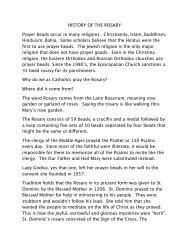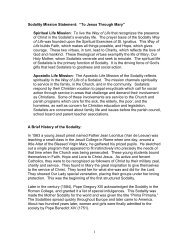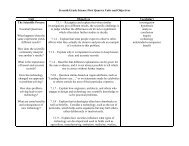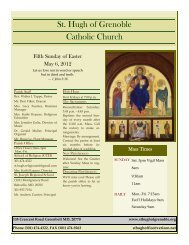+ 8th Grade Science - 1st Quarter Goals (PDF)
+ 8th Grade Science - 1st Quarter Goals (PDF)
+ 8th Grade Science - 1st Quarter Goals (PDF)
Create successful ePaper yourself
Turn your PDF publications into a flip-book with our unique Google optimized e-Paper software.
Eighth <strong>Grade</strong> First <strong>Quarter</strong> <strong>Science</strong> Units and Objectives<br />
Systems on Earth<br />
Essential Questions:<br />
What are the different<br />
layers of Earth?<br />
How are the continents<br />
and ocean basins<br />
constantly changing?<br />
What causes<br />
earthquakes and<br />
volcanoes?<br />
Why is it important to<br />
have the right to refuse to participate.<br />
8.1.6 – Identify the constraints that must be taken into account<br />
as a new design is developed, such as gravity and the<br />
properties of the materials used.<br />
8.1.7 – Explain why technology issues are rarely simple and<br />
one-sided because contending groups may have different<br />
values and priorities.<br />
8.1.8 – Explain that humans help shape the future by<br />
generating knowledge, developing new technologies, and<br />
communicating ideas to others.<br />
8.2.6 – Write clear, step-by-step instructions (procedural<br />
summaries) for conducting investigations, operating<br />
something, or following a procedure.<br />
8.3.1 – Explain that large numbers of chunks of rock orbit the<br />
sun and some of this rock interacts with Earth.<br />
8.3.5 – Explain that everything on or anywhere near Earth is<br />
pulled toward Earth’s center by a gravitational force.<br />
8.3.3 – Explain that the solid crust of Earth, including both the<br />
continents and the ocean basins, consists of separate plates<br />
that ride on a denser, hot, gradually deformable layer of earth.<br />
Understand that the crust sections move very slowly, pressing<br />
against one another in some places, pulling apart in other<br />
places. Further understand that ocean-floor plates may slide<br />
under continental plates, sinking deep into Earth, and that the<br />
surface layers of these plates may fold, forming mountain<br />
ranges.<br />
orbit<br />
gravity<br />
gravitational force<br />
crust<br />
mantle<br />
outer core<br />
inner core<br />
magma<br />
lava<br />
continental plates<br />
tectonic plates<br />
continental drift theory<br />
Pangaea<br />
Laurasia<br />
Gondwanaland<br />
divergent boundary












